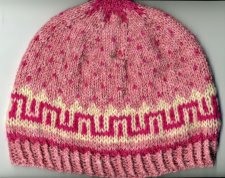I haven't knit a sweater for a long time, mostly because I haven't been pleased with the fit. I've tried dozens of approaches to alterations, and I've unraveled every one. This winter, I had an idea--why not knit a sweater using a successfully-altered sewing pattern as a template?

I hauled out my much used, much altered Kwik-Sew 2900, selected a couple of lace patterns from my Barbara Walker library, and grabbed some soft and fuzzy synthetic yarn that I got cheap long ago (during the G.H.W. Bush administration in College Park, Maryland, I think).
I knit the cardigan top down, and eventually, it was all one piece. I started at the top because running out of yarn near the bottom is preferable--you can make it a shorter sweater or swap in some other yarn and act like it's a design detail. Also, I rely on frequent tryings-on to check fit and appearance.
Knitting to match pattern pieces would be much easier if one were content to knit flat pieces and sew them together, and sensible people avoid knitting set-in sleeves from the top down, but if I were sensible, I'd order an ill-fitting cardigan from a catalog and just put up with it.
Here follows a tediously detailed description of my method, suitable for some idle moments. (Don't feel obliged to read it.)
I cast on stitches for the width across my shoulders, and knit the top of the back first, shaping the arm scythe by adding stitches on each side. (Circular needles are the way to go here, because there are going to be lots of needles with knitting on them for a while.)
When I was almost done shaping the arm scythe, I got more needles, went to the cast-on, and picked up stitches to make the left side front. I knit downward, shaping the neck edge and the arm scythe by adding stitches at the edges, and I managed the full bust adjustment by making three sets of short rows, which work out to be three nice little darts around the armhole and underarm area. (I tried it on frequently at that point.)
Then I did the same thing for the right front. At this point, I had three sets of needles flapping in the breeze, and I needed to add some more stitches at the underarm areas so the sweater would go around me. I had the extra complication of lace panels down the front, which needed to be on the same pattern row or the cardie would look cock-eyed, and I'm probably not attentive enough to keep track of two different spots in a lace pattern.
This was the least fun part. I made sure I had both sides of the front on the same pattern row, and I figured out how many stitches I needed to add at each underarm. I didn't have exactly the same number of stitches on each side front piece, so this is where I needed x more stitches on the left side and y more stitches on the right side to achieve sweater symmetry.
I picked up the left front needles at the cardie opening point, knit around to the end of that piece, cast on x stitches on that needle, then grabbed the needle with the back on it, and knit it onto the same needle as the left front.
Then, I cast on y stitches to the now-quite-full needle, grabbed the needle with the right front on it, and knit across. At last, I had all three chunks of knitting on the same needle. I knit even for a few more inches, and tried it on again, and, fortunately the fit was fine.
I picked up stitches at each shoulder to match the width of the sleeve cap pattern piece--about three inches.I knit back across, picked up a few more stitches, turned and knit back, picked up a few more stitches, turned and knit back, etc. I decided how many stitches to start with and to add at each repeat by holding the sleeve cap pattern up to my knitting. Eventually, I picked up stitches all the way around the armhole, and started knitting in the round. I shaped the sleeve down to the cuff by decreasing whenever it looked right.
I finished both sleeves, and then resumed knitting the body until I ran out of yarn. Then I crocheted the front bands with a different yarn. (I've never knit a really successful button band.)

















































